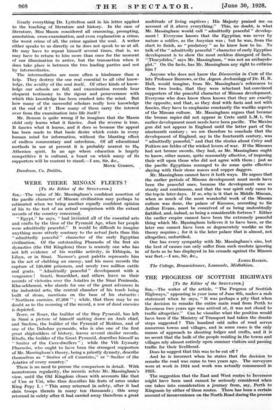WERE THERE MINOAN FLEETS ?
[To the Editor of the SPECTATOR.] Sin,—The value of Mr. Massingham's confident assertion of the pacific character of Minoan civilization may perhaps be estimated when we bring another equally confident opinion of his to the test of an actual comparison with the extant records of the country concerned,
" Egypt," he says, " had indented all of the essential arts and crafts by the time of the Pyramid Age, when her people were admittedly peaceful." It would be difficult to imagine anything more utterly contrary to the actual facts than this " admittedly peaceful " character of the early Egyptian civilization. Of the outstanding Pharaohs of the first six dynasties (the Old Kingdom) there is scarcely one who has not left evidence of his warlike activity, in Ethiopia, in Libya, or in Sinai. Narmer's great palette represents him in the act of clubbing an enemy, and his mace records the capture of 120,000 prisoners, and nearly two million cattle and goats. " Admittedly peaceful " development with a vengeance ! Semti, Semerkhet, and others leave us their records of victories over the Asiatics in the Sinai Peninsula. Kha-sekhemui, who stands for one of the great advances in the industrial arts, the central chamber a his tomb being built of stone, mentions on the base of his statuette : " Northern enemies, 47,209 " ; while, that there may be no doubt as to the meaning of the record, a row of dead enemies is depicted.
Zeser, or Zoser, the builder of the Step Pyramid, has left in Sinai a picture of himself smiting down an Arab chief, and Sneferu, the builder of the Pyraniid of Meidum, and of one of the Dahshur pyramids, who is also one of the first great shipbuilders of history, leaves several similar records. Khufu, the builder of the Great Pyramid, describes himself as " Smiter of the Cave-dwellers " ; while the Vth Dynasty Pharaohs, who ought to have been the strongest supporters of Mr. Massingham's theory, being a priestly dynasty, describe themselves as " Smiter of all Countries," or "Smiter of the Asiatics of every country."
There is no need to pursue the comparison in detail. With monotonous regularity, the records refute Mr. Massiligham's view, until the Old Kingdom closes with accounts like that of Una or Uni, who thus describes his feats of arms under King Pepy I.: " This army returned in safety, after it had slain, troops therein in many ten thousands ; this army returned in safety after it had carried away therefrom a great multitude of living captives ; His Majesty praised me, on account of it above everything " This, no doubt, is what Mr. Massingham would call " admittedly peaceful " develop- ment ! Everyone knows that the Egyptian was never by nature a soldier, as the Assyrian was ; but he was, from the start to finish, as " predatory " as he knew how to be. To talk of the " admittedly peaceful ".character of early Egyptian development is to show the most reckless disregard of facts. "Thucydides," says Mr. Massingham, " was not an archaeolo- gist." On the facts, has Mr. Massingham any right to criticize him ?
Anyone who does not know the Discoveries in Crete of the late Professor Burrows, or the Aegean Archaeology of Dr. H. R. Hall, would imagine, from Mr. Massingbarn's references to these two books, that they were reluctant but convinced supporters of the peaceful character of Minoan development.
Everyone who does know them knows that they are exactly the opposite, and that, as they deal with facts and not with fancies, they have to emphasize constantly the warlike aspects of the Minoan culture. Mr. Massingham argues that because the bronze rapier did not appear in Crete until L.M. 1, the earlier development must needs have been pacific. The Maxim gun did not appear in England until the latter part of the nineteenth century ; we are therefore to conclude that the development of England, say in the fourteenth century, was "admittedly peaceful," and that the stories about Crecy and Poitiers are fables of the wicked lovers of war. If the Minoans had not bronze swords, they had, as Mr. Massingham ought to know, other means, quite reasonably effective, of imposing their will upon those who did not agree with them ; just as the pacific Egyptians managed to do some quite effective slaying with their stone maces and copper daggers.
Mr. Massingham cannot have it both ways. He argues that the earlier periods -of Minoan development must needs have been the peaceful ones, because the development was so steady and continuous, and that the war spirit only came to the top in later days. If so,:why is it that in Middle Minoan, when so much of the most wonderful work of the Minoan culture was done, the palace of Knossos, according to Sir Arthur •Evans, must be conceived of as being undoubtedly fsartified, and, indeed, as being a considerable fortress ? Either the earlier empire cannot have been the extremely peaceful thing which Mr. Massingham believes it to have been, or the later one cannot have been so degenerately warlike as the theory requires ; for it is the later palace that is almost, not altogether, unfortified.
One has every sympathy with Mr. Massingham's aim, but the best of causes can only suffer from such resolute ignoring of facts as he has displayed in his crusade against the Minoan war fleet.—I am, Sir, &c., JAMES Benue.
The Cottage, Broomieknowe, Lasswade, Midlothian.








































 Previous page
Previous page